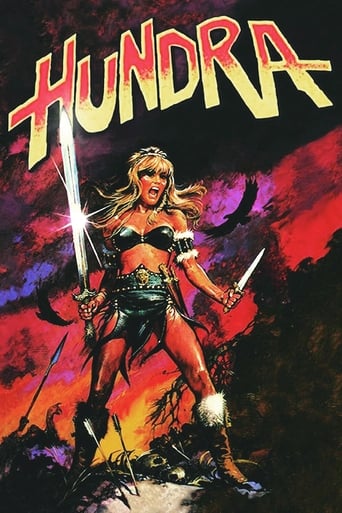Red-Barracuda
In a mythological land, a female tribe is slaughtered by marauding male barbarians leaving the warrior Hundra as the lone survivor. She sets out to find a suitable male to mate with to re-start a new tribe. Soon, she winds up in a walled city run by a group of chauvinistic men.Hundra has the one original angle of being a feminist slant on the sword and sorcery cycle of films from the mid-80's. The genre had been usually typified by scantily clad barbarian women with little in the way of political correctness. So Hundra stands out a little from the crowd, although Red Sonja from a few years later was coming from a similar place. That said, it isn't above having the heroine ride her horse naked into the ocean for an unorthodox bath! In fairness, it's hardly the most gratuitous nudity and the film overall is noticeably less dependent on erotic moments than most others from this type of flick. Laurene Landon is spirited in the title role. She clearly does a lot of her own stunts and gives a very physical performance.It's not a great film though sadly. The main problem is that its pace lags in the middle too much. After a great start the action slows down once the heroine arrives at the city. This means that it feels like the running time could have been reduced by ten to fifteen minutes. But, that said, there are good fight scenes that bookend the film. And the production values overall seem pretty good with some decent locations and a stirring Ennio Morricone score to add some additional class. In the final analysis, Hundra is no classic and is weak in its middle section but it does have some good things about it.
Jonathon Dabell
The inexplicable craze for sword and sorcery during the 1980s saw some good films (Conan The Barbarian, The Beastmaster), some decidedly average film (The Sword And The Sorcerer, Hearts And Armour) and some downright abysmal films (Ator The Invincible, Gor, Deathstalker, and many more which I don't have ample space to list here). The only real surprise is that a genre of such limited appeal managed to stick around for the best part of seven or eight years, especially considering how shamelessly these movies tended to rip each other off. A peculiar sub-genre which arose at the time was that of the 'Feminist Fantasy Film' – best described as Conan-style movies in which the main character is always portrayed by a woman with considerable sword-wielding prowess. Well-known titles in this field would include the likes of Red Sonja, Gwendoline and Barbarian Queen, but the first film to use this idea was actually the 1983 offering Hundra. Alas, apart from introducing a new slant to this Neanderthal genre, Hundra comes across as a pretty dismal movie.A tribe of women survive in the wilderness without a single man amongst their number. The only time they mix with the male species at all is when they wish to be impregnated. Even then, if they give birth to a boy they simply give the baby away and try again until they have a girl. One member of the tribe – fierce, independent warrioress Hundra (Laurene Landon) – refuses to have any dealings with man-folk and proudly declares that she will never have children, preferring instead to hunt and kill and serve as a protector to the tribe. One day, while Hundra is away on an expedition, the entire tribe is slaughtered by an army of men. When Hundra returns, she finds that she is the last of her kind… and the only way she can repopulate the tribe is by going amongst the very men that massacred her brethren to find a suitable mate. She finds the task repugnant but accepts it anyway, as it is the only way to ensure her people will live on. But her fighting instinct refuses to stay down and she is soon leading a rebellion against the men-folk and their chauvinistic ways.It's hard to find many positives to say about Hundra. It has the dubious honour of inventing its own sub-genre, which is something at least, and the score from Ennio Morricone is every bit as lively and catchy as one would expect from this composer. Some of the battle sequences, especially early on, are put together quite competently too (though I would hesitate to call them truly rousing examples of screen spectacle). Apart from that, the film is a pretty sorry affair. None of the actors come across well despite their enthusiasm – the thick sound and awful lighting embarrasses them every step of the way. The film's message is as muddled as its perceived target audience – on the one hand, we are told how misogynistic men are and asked to celebrate as a woman hacks them down to size; yet at the same time we have this crusading warrioress riding around on her horse in the nude, showing plenty of tit, bum and pubic hair. It's like the film sets out to challenge cinematic degradation of women, but is happy to join in with it too, which is confusing and stupid in equal measure. The best way to approach Hundra is as a pure sword and sorcery film – it might not be a very good example of the genre, but it sure beats trying to figure out the movie's unfathomably cockeyed politics!
Woodyanders
Fierce and fearless warrior woman Hundra (a splendidly sassy and spirited portrayal by gorgeous Amazonian blonde goddess Laurene Landon) declares open war on vile and oppressive misogynistic male swine after her whole village gets butchered by a foul horde of guy marauders. Moreover, Hundra must find a worthy man to impregnate her so she can keep the bloodline of her people alive. Ably directed by Matt Cimber, with a clever and witty script by Cimber and frequent collaborator John Goff (the plot basically serves as a nifty metaphor for the many ways men tend to degrade and dominate over women), several stirring and well-staged swordfights, a handy helping of raw and bloody violence (the opening massacre sequence is especially brutal), bright, crisp, glowing widescreen cinematography by John Cabrera, a constant brisk pace, breathtaking Spanish countryside scenery, a decent sprinkling of tasty nudity, a winning sense of tongue-in-cheek humor (at one point Hundra encounters an aggressive face-painted midget on horseback who attacks her with a pitchfork!), and a first-rate rousing'n'robust full-bore orchestral score by the great Ennio Morricone, "Hundra" makes for an immensely fun and satisfying little corker. Neat supporting performances by John Ghaffari as sleazy high priest pimp Nepakin, Ramiro Oliveros as nice, gentle healer Pateray, Maria Casal as obedient and subservient harem girl Tracima, and Tamara as wise elder Chrysula. Best of all, Landon attacks her plumb lead role with tremendously thrilling gusto and passion: Laurene looks simply smashing in her buckskin outfit, wields a truly mean sword, delivers her pro-woman speeches with fiery aplomb, and even performed almost all of her own stunts. A very cool and entertaining romp.
TD
Hundra is one of the best films of its genre. It combines humor and violence with attractive women doing most of the fighting. The movie starts with an ambush of an Amazon village and the destruction of all but one of the Amazon warriors. Her adventures and vengeance ensue in what only can be described as a very fun movie. The light soundtrack adds to the fun as some of the fight sequences come across almost as dance production numbers. But, it's not all fun and games. The characters can be and often are vicious and kill their opponents without mercy. This movie is 100 times better than its sister film "Yellow Hair and the Fortress of Gold" also starring Laurene Landon and filmed back to back.


